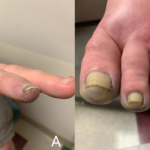“Do you seriously want me to stand on my tiptoes?” my gruff 68-year-old patient at the VA Rheumatology Clinic asked, incredulous. “I came with a walker. I think you very well know, doc, that if I get on my tippy-toes, then I’m going to fall flat on my face.”
He had a point, one that I simply couldn’t argue against. Toe-walking, as much as it’s part of the routine that some of my attending physicians insist every single patient perform, doesn’t serve much purpose as a universal “screening” physical exam test. In fact, the more I thought about it, the more I started to feel like, if I were in his shoes, I would be even more upset. As a doctor, I wasn’t really asking him to do something to help advance the diagnosis or management; I was asking him to stand on his tip-toes just because I wanted him to do so. And it got me thinking: As much as I enjoy the art of the physical examination, if a maneuver doesn’t serve a practical purpose, then why should we insist on wasting our patients’ (and our own) time?
The more I explored this idea, the more I came to realize the scarcity of evidence to support much of what we do in the clinic. In fact, if we held the physical exam to the same standards that we hold laboratory testing and diagnostic imaging studies, I am certain our clinical encounters would be far briefer. It was both enlightening and disillusioning to see that certain mainstays of the clinical exam, such as the tests for carpal tunnel syndrome or those for rotator cuff tendinitis, have, at best, “reasonable” sensitivities and specificities. And even then, inter-observer reliability can be so variable that clinical utility is highly suspect. It’s no wonder we rely so heavily on laboratory testing and imaging, given that we’re not even sure whether we should believe what we see, hear or touch in the clinical setting.
Of course, the one great advantage the physical exam has over these other forms of testing is that it’s mostly free. But just because it’s cheap doesn’t mean it comes without risk. In truth, what we call “maneuvers” are actually procedures in their own right. And like any procedure, these maneuvers have their own risks and benefits.
One (extreme) example is elicitation of pathergy. Senior attending physicians often admonish us fellows for not testing for pathergy more frequently, which admittedly is relatively specific for Behçet’s disease. But it doesn’t seem right to discomfort the patient and possibly introduce a source for infection by inserting a needle into a patient’s arm just to “see out of curiosity if it’s there.” Besides, even if the test were negative, in a patient with recurrent genital and oral ulcerations without an alternate explanation, we probably wouldn’t be able to cross Behçet’s off our list. So why even bother exposing the patient to this risk for only a marginal benefit? Of course, that’s a bit of an extreme example, but if we’re going to try to provoke pain by compressing, stretching or otherwise manipulating joints, why even discomfort the patient at all if the procedure will not, for the most part, change the course of management?



